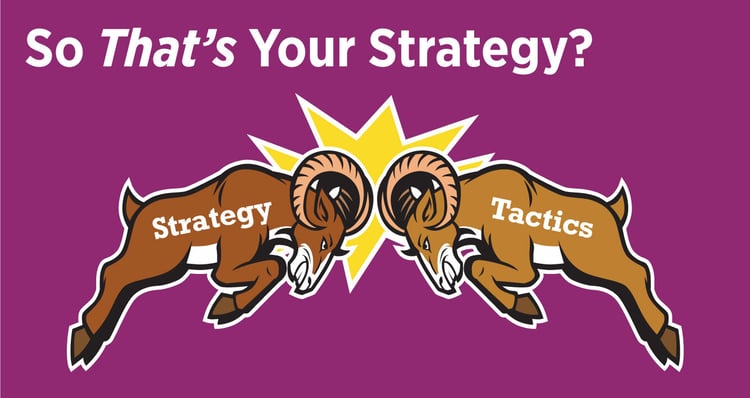
People look smart when they reference strategy. It elevates any discussion to greater importance as soon as the word strategy enters. Often, it gets others in the room thinking, “Right, maybe I’m not thinking about this strategically.” Followed by the thought, “What exactly would a strategic version of this discussion look like?”
The idea of strategy is often misunderstood. I fully admit, it really can be difficult. I can’t tell you how many discussions I’ve been in where people describe their tactical execution plan as the strategy.
A simple example of why folks get confused, and I’ll use what we know best, the world of marketing: Your marketing strategy to enroll more students requires great marketing content. Content is a tactic you will employ to achieve your strategic goal. Yet, you will need a content strategy to be successful. So, content is not a tactic. It is a strategy, right? No, it is a tactic in this scenario. A tactic that needs its own strategy.
Oy vey.
Our team, of course, lives in the world of marketing strategy, planning, and execution. Today's post shares some insights into how to simplify the discussion and confirm when you are employing a strategy vs. discussing the tactical execution of any given initiative.
Read on and maybe we can shed some light on how to actually be smart in the discussion, not just look smart.
So much confusion in use of these terms and how to think about them.
Let’s suppose we had a very healthy marketing budget to launch our new super duper, career-focused, executive education programs. To achieve the goals of our overarching marketing strategy we will execute a range of marketing tactics from market research to promotion.
Your tactics for market research lead to great message and creative development:
- market trend analysis
- competitor analysis
- consumer focus groups
- consumer surveys
Your tactics for promotion produce results measured against your goals/targets:
- digital marketing
- paid search
- paid social
- organic social
- influencer marketing (product placement)
- video distribution (OTT)
- podcast distribution (thought leadership)
- direct mail
- PR/media relations
Are each of these tactics going to adhere to the overarching strategy? You’re darn tootin’ they will. And will each of these tactics have their own strategy? You’re darn tootin’ right again!
How can that be? Tactics have strategies?
Simplifying All of This
Let’s clear this up right now. And it’s really pretty simple. When you see others using the term “strategy” simply replace it with the concept of differentiation. Michael Porter of Harvard Business School fame, talks about competitive positioning within the marketplace, which is all about identifying and promoting your differentiators.
So, with your market research tactics, you learn that the business-focused executive education program you’ve designed is basically offering exactly what others are offering in terms of academic content. You’ve designed it to take nine months to complete which is in line with other offerings. Your pricing is also comparable to other options. How will you stand out?
Turns out, 4 of your 6 exec ed professors all have deep industry experience in the healthcare industry – hospital administration, medical technology, legal liability, and physician group management. While there is competition out there for this specialty area, you can round out this team expertise and develop a unique position in the marketplace to establish and exploit a differentiator. Your program is no longer generic.
Your marketing team goes to work identifying how each marketing tactic will employ compelling messaging on each of the marketing channels you choose (paid social, OTT, PR) to leverage your differentiator.
Thinking more about competitive positioning, your market research has identified that the other strong competitive programs in the market our primarily touting their programs through paid social and SEM (search engine marketing). And they are touting the time to complete the program as a career accelerant – appealing to the executive crowd.
So, your decision to use PR and thought leadership as a way of touting how amazing your program is and how executives will benefit would stand out in the field. Or your decision to go head-to-head against your competing programs in the digital marketing arena could work. But you are going to want your messaging and content strategy to differentiate your program.
As you promote your differentiator, can you also promote your more generic business exec ed offering? Absolutely! There are prospective students who will take note of that non-healthcare track as well. All this thinking can apply to your engineering track, your digital analytics track, etc.
The marketing tactics you choose to employ to reach your target audience each require an approach that puts you at a competitive advantage. This is how your tactics each have a strategy. By choosing tactics from your list that differentiate your program, you are thinking strategically. You are simply making sure that your program stands out in a way that appeals to your audience, drives traffic and enrollment.
Your market research (focus groups and the like) should have identified what prospective students value most in a program like this. Perhaps your prospective students are driven by a desire for innovation. Perhaps they see the growth of ambulatory care and feel the future of their career will be stronger if they can become expert in the administration of this aspect of the healthcare industry.
These are all consumer and industry insights that help you define the overarching strategy and then the strategy for your use of messaging, marketing channel selection, and every other tactic you will use to position your program against competitors.
A word to the wise: generic messaging about your personal approach to helping students achieve their goals is not a competitive differentiator when every competitor says the same thing.
So, the next time someone on your team brings up “strategy” or asks if we are being “strategic” in our approach, and they are doing it just to sound smart or superior, go to the whiteboard and share this classic gem from Sarah Cooper to lighten the mood.
 Source: TheCooperReview.com
Source: TheCooperReview.com
And then summarize how your plans help the institution stand out from the competition and your initiatives all adhere to these clear strategic advantages (or differentiators). Keep it simple and clear so your colleagues can understand how their work contributes to the larger success, to your specific and clearly stated goals.
The bottom line
Strategy all comes down to two things:
1) capitalizing on long-term opportunities and
2) using differentiation to achieve the position you want.
It’s all about differentiation. Each tactic you choose (using blogs, Instagram, TikTok, channel partners, or media relations), each one needs its own strategic approach to get your message to stand out against the competition. Which is why your strategy has tactics and your tactics each have a strategy.
Now it’s clear as day, right?
Next week we’ll talk a bit more about how to figure out what your strategy ought to be.
Let us know if you’d like to chat, and we’ll dive deeper into it.



